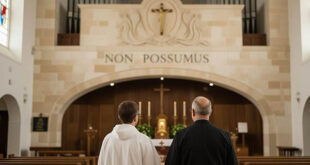The Bible is at the heart of the spiritual life of Christians. It is not only the sacred text that reveals God’s plan of salvation, but also a guide for our daily lives. However, the interpretation of Scripture has always been a complex task, leading to multiple approaches, questions, and challenges throughout the centuries. Today, in an increasingly pluralistic and complex world, it is more important than ever to approach the Bible in a way that is faithful to the tradition of the Church and, at the same time, relevant for the present day. In this article, we offer practical keys for a deep, spiritual reading of Sacred Scripture, in harmony with the teaching of the Catholic Church.
1. The Literal and Spiritual Senses: Two Complementary Approaches
The Catholic Church has always maintained that the interpretation of Scripture must consider both the literal and the spiritual sense of biblical texts. These two levels of interpretation are not in conflict but complement each other.
The Literal Sense
The literal sense is the starting point for all biblical reading. This sense refers to the meaning that the human author, inspired by the Holy Spirit, intended to convey at the time of writing. To understand this sense, it is essential to place the passage in its historical, cultural, and literary context. Who wrote it? When and why? What literary genre is the author using?
For example, when we read Jesus’ parables, such as the Parable of the Good Samaritan (Luke 10:25-37), we know it is not a literal historical account, but a moral teaching that uses a symbolic narrative to convey a profound message about love for one’s neighbor.
The Spiritual Sense
Beyond the literal sense, the Church recognizes a spiritual sense in Scripture, which can be divided into three levels:
- The allegorical sense: This is when the events narrated in the Bible not only have historical significance but also prefigure other events. For example, the crossing of the Red Sea by the Israelites (Exodus 14) prefigures Christian baptism.
- The moral sense: Scripture also teaches us how to live according to God’s commandments, giving us practical and ethical lessons. A clear example is the Sermon on the Mount, where Jesus presents the Beatitudes (Matthew 5:1-12), a guide for living in holiness.
- The anagogical sense: This sense refers to ultimate realities, such as heaven and eternal life. It invites us to look toward the future, toward our hope in eternal glory. The New Jerusalem described in the book of Revelation (Rev 21:1-4) is a symbol of eternal life with God.
2. The Unity of Scripture: Christ as the Center of the Bible
A fundamental key to properly interpreting Scripture is understanding its intrinsic unity. Although the Bible is made up of various books, written in different times and by different authors, they are all inspired by the same Holy Spirit and share a common thread: Jesus Christ.
The Second Vatican Council, in its dogmatic constitution Dei Verbum, teaches that “the economy of the Old Testament was chiefly designed to prepare for, announce prophetically, and indicate in various ways the coming of Christ.” Therefore, the entire Bible, from Genesis to Revelation, points to Christ. When reading the Old Testament, it is essential to do so in the light of the New Testament, seeing how the promises, figures, and prophecies of the former find their fulfillment in Christ.
For example, the sacrifice of Isaac by Abraham (Genesis 22) prefigures the sacrifice of Christ on the cross. Abraham, willing to offer his son, is an image of God the Father who gives His only Son for our redemption.
3. The Living Tradition of the Church: A Guide to Interpretation
For Catholics, the Bible is not an isolated text to be interpreted entirely independently. Since the early centuries of Christianity, Tradition has played a crucial role in the interpretation of Scripture. The Church, guided by the Holy Spirit, has been entrusted with the task of preserving and transmitting the authentic faith, and this task includes the proper interpretation of the Bible.
The Church Fathers, such as St. Augustine and St. Jerome, performed invaluable work by delving deeply into the meaning of Scripture. They, along with the Councils and Popes, have left us a legacy of teachings that illuminate our reading of the Bible today.
A practical example of how Tradition helps interpret Scripture is the dogma of the Immaculate Conception of Mary. Although this dogma is not explicitly detailed in Scripture, the Church has defined it based on theological reflection and key biblical passages, such as the angel’s greeting to Mary in Luke 1:28: “Hail, full of grace.” This expression, “full of grace,” has been interpreted in the light of Tradition as a sign that Mary was preserved from original sin from her conception.
4. The Magisterium and the Principles of Interpretation
The Magisterium of the Church, meaning the teaching authority formed by the Pope and the bishops in communion with him, has the mission of authentically interpreting the Word of God. This does not mean that the Church imposes a rigid or uniform reading of every biblical passage, but it does provide principles for an interpretation faithful to the revealed message.
Among these principles, the following stand out:
- Reading in communion with the whole of Scripture: No biblical passage can be interpreted in isolation, outside the context of the entirety of the Bible.
- The analogy of faith: The interpretation of Scripture must be in harmony with the teachings of the Church. A text cannot be interpreted in a way that contradicts an already established truth of faith.
- Respect for literary genres: The Bible contains many literary genres, such as poetry, prophecy, history, and letters. Each of these genres must be read appropriately, understanding that poetic language should not be interpreted in the same way as historical narrative.
5. The Importance of Prayer and the Holy Spirit
Beyond technical principles, the spiritual reading of the Bible requires the action of the Holy Spirit. Scripture is an inspired text, and to truly understand it, we need to open ourselves to divine light. Before reading the Bible, it is helpful to say a simple prayer, asking the Holy Spirit to enlighten us and help us understand what God wants to say to us through His Word.
St. Jerome said, “Ignorance of Scripture is ignorance of Christ.” Therefore, when we approach the Bible, we must do so with an attitude of humility, knowing that it is not just a book to be studied intellectually but a living Word that speaks to us today.
6. Lectio Divina: A Method of Prayerful Reading
One of the richest and deepest ways to read the Bible in the tradition of the Church is through Lectio Divina. This ancient method of prayer with Scripture consists of four steps:
- Lectio (reading): Read the text slowly and attentively, trying to understand its literal meaning.
- Meditatio (meditation): Reflect on the text, allowing the words or phrases that most resonate with your heart to echo within you.
- Oratio (prayer): Respond to God with personal prayer, based on what you have meditated upon.
- Contemplatio (contemplation): Remain in silence, in the presence of God, allowing His Word to transform your heart.
Conclusion: A Living Word for Today’s World
Interpreting the Scriptures today requires a balance between rigorous study and spiritual openness. The Bible is not just an ancient text; it is the living Word of God that speaks to us in our current reality. By reading it in communion with the Church, guided by the Holy Spirit and rooted in tradition, we can discover its infinite richness and apply it to our daily lives.
The Bible remains an inexhaustible source of wisdom, comfort, and guidance for Christians of all generations. In a world that is constantly changing, God’s Word remains unchanging, offering deep answers to the most urgent questions of our time. May the study, prayer, and meditation of Scripture draw us closer to Christ, the Word made flesh, and help us be a light to a world in need.






